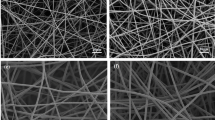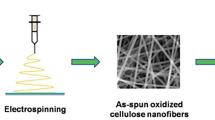Abstract
In this work, water-insoluble and biocompatible hydrogel nanoweb was prepared via electrospinning. Sodium carboxymethyl cellulose (CMCNa), the cellulose derivative with water solubility and biocompatibility, was electrospun with help of building polymer, poly(ethylene oxide) (PEO). After removal of PEO, the CMCNa in the nanoweb was ionically crosslinked by FeCl3. The viscosity of the mixed solution was decreased with the increase of PEO content mainly due to the smaller molecular size of PEO comparing to CMCNa. The reduced interaction resulted from small molecular size decreased the viscosity with the increase of PEO content. The PEO also improved the spinnability of the solution by screening repulsive force between the CMCNa molecules. As a result, the increase of PEO content resulted in the decreases of the viscosity and the fiber diameter simultaneously. After extraction of PEO, the diameter was significantly reduced. The surface of the nanowebs became bumpy after crosslinking and fiber diameter increased with the increase of crosslinking time. The chemical structure changes of the nanowebs during the process were analyzed by FT-IR spectra. The cytotoxicity of the nanoweb was also assessed using MTT assay. Furthermore, the drug release behaviors of the nanowebs were evaluated using UV–Vis spectrometer. The nanoweb with increased fiber diameter showed more sustained release behavior because of its low specific surface area.









Similar content being viewed by others
References
Ahmed EM (2015) Hydrogel: preparation, characterization, and applications: a review. J Adv Res 6:105–121
Akalin GO, Pulat M (2018) Preparation and characterization of nanoporous sodium carboxymethyl cellulose hydrogel beads. J Nanomater 2018:1–12
Akhtar MF, Hanif M, Ranjha NM (2016) Methods of synthesis of hydrogels: a review. Saudi Pharm J 24:554–559
Basu P, Repanas A, Chatterjee A, Glasmacher B, NarendraKumar U, Manjubala I (2017) PEO–CMC blend nanofibers fabrication by electrospinning for soft tissue engineering applications. Mater Lett 195:10–13
Caló E, Khutoryanskiy VV (2015) Biomedical applications of hydrogels: A review of patents and commercial products. Eur Polym J 65:252–267
Capanema NS, Mansur AA, de Jesus AC, Carvalho SM, de Oliveira LC, Mansur HS (2018) Superabsorbent crosslinked carboxymethyl cellulose-PEG hydrogels for potential wound dressing applications. Int J Biol Macromol 106:1218–1234
Chang C, Zhang L (2011) Cellulose-based hydrogels: present status and application prospects. Carbohydr Polym 84:40–53
Chang C, Zhang L, Zhou J, Zhang L, Kennedy JF (2010) Structure and properties of hydrogels prepared from cellulose in NaOH/urea aqueous solutions. Carbohyd Polym 82:122–127
Chen YM, Sun L, Yang SA, Shi L, Zheng WJ, Wei Z, Hu C (2017) Self-healing and photoluminescent carboxymethyl cellulose-based hydrogels. Eur Polym J 94:501–510
Chen C, Li D, Abe K, Yano H (2018a) Formation of high strength double-network gels from cellulose nanofiber/polyacrylamide via NaOH gelation treatment. Cellulose 25:5089–5097
Chen Y, Teng N, Chen H, Chen J, Liu F, Na H, Zhu J (2018b) Evaluation of electrospinnability of celluloses derived from different biomass resources. Fibers Polym 19:1128–1134
Davidson DW, Verma MS, Gu FX (2013) Controlled root targeted delivery of fertilizer using an ionically crosslinked carboxymethyl cellulose hydrogel matrix. SpringerPlus 2:318
Du H, Liu W, Zhang M, Si C, Zhang X, Li B (2019) Cellulose nanocrystals and cellulose nanofibrils based hydrogels for biomedical applications. Carbohydr Polym 209:130–144
Flory P (1953) Principles of polymer chemistry. Cornell University, Ithaca, NY
Frenot A, Henriksson MW, Walkenström P (2007) Electrospinning of cellulose-based nanofibers. J Appl Polym Sci 103:1473–1482
Garcia C, Martínez F, Bossard F, Rinaudo M (2018) Biomaterials based on electrospun chitosan. Relation between processing conditions and mechanical properties. Polymers 10:257
Heinze T, Dicke R, Koschella A, Kull AH, Klohr EA, Koch W (2000) Effective preparation of cellulose derivatives in a new simple cellulose solvent. Macromol Chem Phys 201:627–631
Hu Y et al (2017) Highly flexible polymer-carbon dot-ferric ion nanocomposite hydrogels displaying super stretchability, ultrahigh toughness, good self-recovery and shape memory performance. Eur Polym J 95:482–490
Jeong D, Joo S-W, Hu Y, Shinde VV, Cho E, Jung S (2018) Carboxymethyl cellulose-based superabsorbent hydrogels containing carboxymehtyl β-cyclodextrin for enhanced mechanical strength and effective drug delivery. Eur Polym J 105:17–25
Kamel S, Ali N, Jahangir K, Shah S, El-Gendy A (2008) Pharmaceutical significance of cellulose: a review. Express Polym Lett 2:758–778
Kamoun EA, Kenawy ERS, Chen X (2017) A review on polymeric hydrogel membranes for wound dressing applications: PVA-based hydrogel dressings. J Adv Res 8:217–233
Kanani AG, Bahrami SH (2010) Review on electrospun nanofibers scaffold and biomedical applications. Trends Biomater Artif Organs 24:93–115
Kim C-W, Kim D-S, Kang S-Y, Marquez M, Joo YL (2006) Structural studies of electrospun cellulose nanofibers. Polymer 47:5097–5107
Kim MS, Park SJ, Gu BK, Kim C-H (2012) Ionically crosslinked alginate–carboxymethyl cellulose beads for the delivery of protein therapeutics. Appl Surf Sci 262:28–33
Li J, Mooney DJ (2016) Designing hydrogels for controlled drug delivery. Nat Rev Mater 1:16071
Lindman B, Karlström G, Stigsson L (2010) On the mechanism of dissolution of cellulose. J Mol Liq 156:76–81
Liu X, Lin B, Zhang Z, Lei H, Li Y (2016) Copper(ii) carboxymethylcellulose (CMC-Cu II) as an efficient catalyst for aldehyde–alkyne–amine coupling under solvent-free conditions. RSC Adv 6:94399–94407
Luo X, Zhang L (2013) New solvents and functional materials prepared from cellulose solutions in alkali/urea aqueous system. Food Res Int 52:387–400
Murugan R, Ramakrishna S (2007) Design strategies of tissue engineering scaffolds with controlled fiber orientation. Tissue Eng 13:1845–1866
Park B, Hong JH, Kim H (2012) Spinline behavior and web morphology in multi-nozzle electrospinning of PAN/DMF solution. Fibers Polym 13:850–854
Ryu GS, Oh JT, Kim H (2010) Observation of spinline behavior of dual nozzle electrospinning and its fiberweb morphology. Fibers Polym 11:36–41
Sakai S, Kawakami K, Taya M (2012) Controlling the diameters of silica nanofibers obtained by sol–gel/electrospinning methods. J Chem Eng Jpn 45:436–440
Shenoy SL, Bates WD, Frisch HL, Wnek GE (2005) Role of chain entanglements on fiber formation during electrospinning of polymer solutions: good solvent, non-specific polymer–polymer interaction limit. Polymer 46:3372–3384
Swamy BY, Yun Y-S (2015) In vitro release of metformin from iron(III) cross-linked alginate–carboxymethyl cellulose hydrogel beads. Int J Biol Macromol 77:114–119
Swatloski RP, Spear SK, Holbrey JD, Rogers RD (2002) Dissolution of cellose with ionic liquids. J Am Chem Soc 124:4974–4975
Xu J et al (2018) Engineering biocompatible hydrogels from bicomponent natural nanofibers for anticancer drug delivery. J Agric Food Chem 66:935–942
Yasuda K, Armstrong R, Cohen R (1981) Shear flow properties of concentrated solutions of linear and star branched polystyrenes. Rheol Acta 20:163–178
Yoon MJ, Doh SJ, Im JN (2011) Preparation and characterization of carboxymethyl cellulose nonwovens by a wet-laid process. Fibers Polym 12:247–251
Zheng WJ, Gao J, Wei Z, Zhou J, Chen YM (2015) Facile fabrication of self-healing carboxymethyl cellulose hydrogels. Eur Polym J 72:514–522
Acknowledgments
This research was supported by the National Research Foundation of Korea (NRF) funded by the Ministry of Science (NRF-2018R1A2B6003570). This research was supported by the National Research Foundation of Korea (NRF) Grant funded by the Ministry of Science and ICT for First-Mover Program for Accelerating Disruptive Technology Development (2018M3C1B9069748).
Author information
Authors and Affiliations
Corresponding author
Additional information
Publisher's Note
Springer Nature remains neutral with regard to jurisdictional claims in published maps and institutional affiliations.
Rights and permissions
About this article
Cite this article
Ko, E., Park, K.S., Kim, S. et al. Morphological study of cellulosic hydrogel nanofiber for biomedical application. Cellulose 26, 9107–9118 (2019). https://doi.org/10.1007/s10570-019-02725-1
Received:
Accepted:
Published:
Issue Date:
DOI: https://doi.org/10.1007/s10570-019-02725-1




